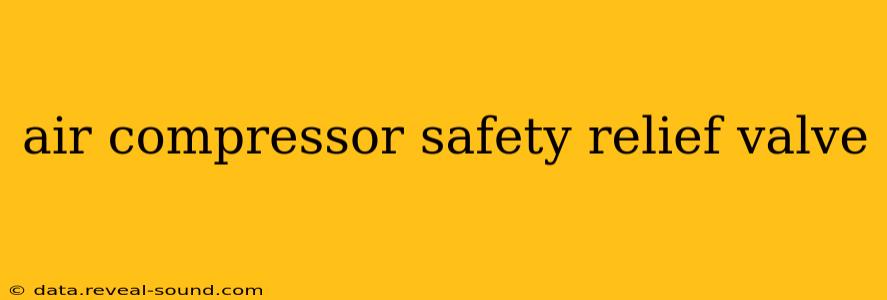Air compressors are powerful tools used across various industries and in countless homes. However, the pressurized air they generate necessitates robust safety measures, and the safety relief valve is paramount among them. This valve is a critical component designed to prevent catastrophic failures by releasing excess pressure when the compressor surpasses its safe operating limits. Understanding its function, maintenance, and potential issues is crucial for safe and efficient operation.
What is an Air Compressor Safety Relief Valve?
An air compressor safety relief valve, also known as a pressure relief valve or safety valve, is a pressure-actuated device that automatically opens when the pressure within the compressor tank exceeds a predetermined setpoint. This prevents over-pressurization, which could lead to tank rupture, explosions, and serious injuries. The valve releases compressed air to the atmosphere, thus relieving the excess pressure and returning the system to a safe operating level. Different types of valves exist, each with its own mechanism and pressure rating.
How Does an Air Compressor Safety Relief Valve Work?
The operation hinges on a simple principle: pressure differential. Most safety relief valves utilize a spring-loaded mechanism. When the pressure in the tank surpasses the setpoint, the force of the compressed air overcomes the spring's resistance, forcing the valve open. Compressed air is then released until the pressure drops below the setpoint, at which point the spring closes the valve. This entire process is automatic and crucial to the safe operation of the compressor.
What Happens if the Safety Relief Valve Fails?
A malfunctioning safety relief valve is extremely dangerous. If the valve fails to open when needed, the pressure within the tank will continue to rise until the tank's structural integrity is compromised. This could result in a catastrophic tank failure, potentially causing serious injury or death. Therefore, regular inspection and maintenance of this valve are non-negotiable.
How Often Should I Test My Air Compressor Safety Relief Valve?
The frequency of testing depends on the compressor's use and manufacturer's recommendations. However, a general guideline is to test the valve at least once a year, or more frequently if the compressor is used extensively in demanding applications. Testing involves carefully increasing the tank pressure until the valve opens, verifying it releases air and then reseals correctly as the pressure drops. Never attempt this without understanding your compressor's operation and safety procedures.
What are the Different Types of Air Compressor Safety Relief Valves?
Several types exist, each with slightly different mechanisms and pressure ratings:
- Spring-loaded valves: These are the most common type, relying on a spring to control the opening and closing of the valve.
- Pilot-operated valves: These use a pilot signal to control the opening and closing of the main valve, often providing more precise pressure control.
- Weight-loaded valves: These use a weight to counter the pressure, simpler than spring-loaded options, but less precise.
The type of valve used will depend on the compressor's design and pressure requirements.
How Can I Tell if My Air Compressor Safety Relief Valve is Malfunctioning?
Several signs indicate potential problems:
- The valve is leaking: A slow leak indicates a problem with the valve's sealing mechanism.
- The valve is stuck open: This leads to a continuous loss of compressed air.
- The valve is not opening when it should: This is the most dangerous scenario, as it increases the risk of a tank rupture.
Any of these signs necessitate immediate action—stop using the compressor and seek professional assessment.
How Do I Maintain My Air Compressor Safety Relief Valve?
Regular maintenance is essential for the longevity and proper functioning of the safety relief valve. This typically involves visual inspection for damage, corrosion, or leaks. Again, consult your compressor's manual for specific maintenance instructions. Never attempt repairs unless you are properly trained and qualified.
Can I Replace an Air Compressor Safety Relief Valve Myself?
While some individuals may feel capable of replacing the valve, it is generally recommended to seek a qualified technician. Incorrect installation can compromise safety and render the valve ineffective. The potential for injury or damage warrants professional attention.
By understanding the function and importance of the air compressor safety relief valve, and performing regular inspections and maintenance, you can ensure the safe and efficient operation of your compressor. Remember, safety should always be the top priority.
